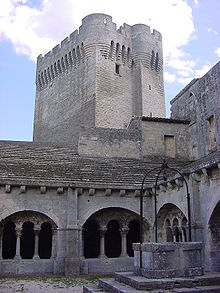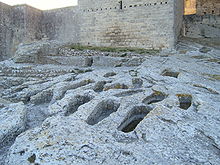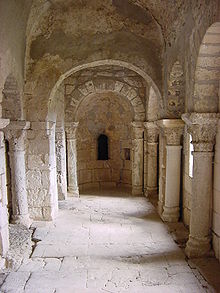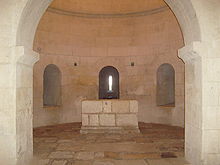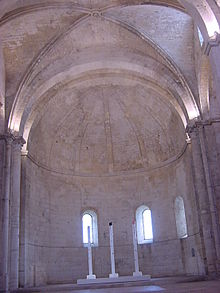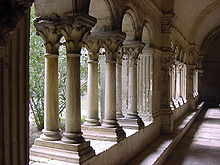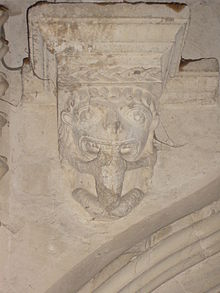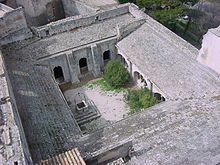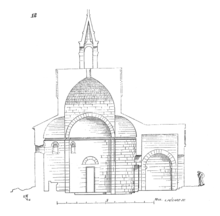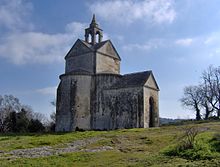- Montmajour Abbey
-
Montmajour Abbey (French: Abbaye Notre Dame de Montmajour) is a fortified Benedictine monastery built between the 10th and 13th century on what was then an island five kilometers north of Arles, in the Bouches-du-Rhône département, Provence, in the south of France.
The Abbey is noted for its 11th-14th century graves, carved in the rock, its subterranean crypt, and its massive unfinished church. It was an important pilgrimage site during the Middle Ages, and in the 18th century it was the site of a large Maurist Monastery, now in ruin. The abbey is cared for as a historic monument by the Centre des monuments nationaux.
Early History and Legends of Montmajour
Until the late Middle Ages Montmajour was an island, 43 meters high, surrounded by marshes and accessible only by boat. Beginning in the third millennium BC the island was used as a cemetery, with individual graves carved into the rock. In the 9th and 10th centuries the island also served as a sanctuary for the local residents during invasions of the Saracens and the Normans.[1]
During the Middle Ages, several legends arose about Montmajour and its founding. One legend said that the island had been the sanctuary of St. Trophimus, who had been sent from Rome by St. Peter to convert the Gauls. After coming to Arles in 46 AD, he took shelter in one of the caves on the island and received disciples there. A rock cell under the church is called "The Confessional of St. Trophimus."
Another legend said that the graves were those of soldiers of Charlamagne, who had fought against the Saracens. A third legend said that the first church was founded by King Childebert I, the son of Clovis, when he saw fervor of a group of anchorite hermits on the island.
Chronology
- 943 - A Frankish noblewoman, Teucinde, acquires the island from the Church of St. Trophime in Arles, and leaves it in her will to a group of monks, with instructions to create an Abbey following the Rule of St. Benedict.
- 963- Pope Leo VIII puts the Abbey under his direct patronage.
- 11th Century - St. Peter's Chapel is constructed into the rock on the south side of the hill, near the cemetery.
- 1030- The Abbey acquires what is believed to be a fragment of the True Cross. A chapel of the Abbey church is dedicated to the relic, and the church becomes a major pilgrimage site. Absolution for their sins is given to all who come there on May 3, feast day for the Discovery of the True Cross, and leave a donation for the completion of the Abbey. By the 12th century the pilgrimage had become so popular that the Abbey had to build a separate church, the Chapel of the Holy Cross, for the relic.
- 12th Century - The Abbey is at the peak of its influence and wealth. It possesses vineyards, cornfields, olive groves, waterways, mills, fisheries and forests, and has dependent priories and land all over Provence, and as far away as Frejus, Sisteron and Grenoble. The rulers of Provence give the Abbey land, castles, and even entire towns, such as Pertuis.
- Construction of the Abbey Church of Our Lady is begun, but because of a shortage of money, only the first two bays are completed.
- 13th Century - The Abbey has sixty resident monks, a large number for the Middle Ages.
- 1348 - The Black Plague reduces by half the population of Provence.
- 1357 - The Grandes Compagnies, armies of French soldiers left unpaid after the French defeat by the English at Poitiers during the Hundred Years War, ravage the countryside. The countryside was pillaged again by marauders in 1357, and by the soldiers of Raymond de Turenne of Les Baux, who waged war against Arles from 1386 to 1398. The Abbot of Montmajour, Pons de L'Orme, fortifies the monastery with a massive tower. Widespread starvation and destruction in Provence.
- 1593 -During the Wars of Religion, the Abbey is occupied by soldiers of the Catholic League, and the monks are forced to move to Arles for two years. When they return, they find the monastery ruined.
- 1639 Against the wishes of the majority of monks, the Abbey is given to a new order, the Maurists, a reformed Benedictine order based at the Abbey of Saint-Germain-des-Prés in Paris. Despite the hostility of the "old" monks, and of the Abbot, Charles Bichi, whose family had purchased his title from the King, who did not reside at the Abbey and refused to pay for its upkeep, the Maurists began a program of restoration and construction.
- Though the Maurists monks numbered only thirty, their construction program was grandiose - they began a classical building designed to have twenty-five bays along its north and south facades. Sixteen bays were completed by the time of the French Revolution.
- 1786- the titular Abbot, Cardinal Louis de Rohan, refuses to pay for any more upkeep of the Abbey. The Abbey is officially secularized.
- 1789 -At the time of the French Revolution, only nine monks remain at Montmajour.
- 1791-1793 The monastery is sold for 62,000 livres to Elizabeth Roux-Chatelard, who strips the Maurist building and leaves it in ruins. The property is then resold to twenty different owners. The medieval part is used for a sheep farm and haylofts.
- 1797- the painter Jacques Réattu buys the Pons de l'Orme tower, saving it from destruction.
- 1822- The city of Arles buys the Chapel of the Holy Cross from a fisherman, and preserves it.
- 1840- the writer Prosper Mérimée, inspector of ancient monuments, puts the Abbey on the first list of French historical monuments which should be preserved. Restoration begins on some of the buildings in 1862, and continues for decades.
- 1859- The last of the romanesque and gothic properties are purchased by the state. The Maurist building is not purchased until 1921.
- 1944 - a major fire breaks out inside the abbey church, which is being used by the German Army as an arms depot.
St. Peter's Chapel (11th Century)
St. Peter's chapel is the oldest existing part of the Abbey, probably built between 1030 and 1050.[2] It consists of a narthex and two parallel naves, the older one cut into the rock on the south side of the hill, and an arcade of rounded Romanesque arches resting on columns, creating openings to the rock cemetery. The columns are older than the church, and probably come from Roman buildings in Arles; but the capitals of the columns are carved with Romanesque floral designs. The southern nave is complete with a choir and a semi-circular apse.
Inside the chapel a passage leads to what appears to be a natural cave, with a small window, which according to tradition was the home of St. Trophimus and the first monks to live on the island.
The Rock Cemetery (11th-14th century)
The rocky slope near St. Peter's Chapel is has more than a dozen tombs cut into the rock in the shape of human bodies, with places for the head, shoulders and feet. The more recent tombs (14th century) were rectangular, and were probably covered with stone slabs. Most of the tombs are oriented with the feet toward the east, the direction of the sunrise and the Resurrection.
The Chapel of the Holy Cross (12th century)
The Chapel of the Holy Cross (French: Chapelle de Sainte-Croix) was built to contain the most valuable relic in the Abbey, a piece of the True Cross. It is located a few hundred meters from the Abbey Church, outside the monastery walls, and is in the shape of a cross, with a vestibule on the north side, and four semicircular apses with semicircular domes around a square bay with a cloister vault. The vault is crowned by a perfect stone square, topped by triangular pediments and a small tower. The cornices and pediments are decorated with dentils. The building, with its dignity, simplicity, symmetry and perfect craftsmanship, is considered a masterpiece of Romanesque architecture.
The Crypt of St. Benedict (12th century)
The crypt of St. Benedict is partly dug into the rock of the hill and partly built of massive stone walls, perfectly cut. It features a transpect with two absidioles, or small chapels, and a passage which leads to a small rotunda which is crowned with a cupola. The rotunda is surrounded by an ambulatory a tall, narrow circular corridor with a stone barrel vault. On its outer side, the ambulatory opens into five radiating chapels, each with its own window catching the eastern light, and its own small barrel-vaulted choir bay and semi-domed apse. The large number of small chapels allowed the large number of monks in the Monastery to quickly celebrate the morning mass. A striking feature of the crypt is the smooth quality of the stone work- the stones are perfectly cut and fitted, and their only texture is the slight rippling caused by dressing the stone with the help of a toothed hammer.[3]
The massive church on top of the crypt has a single nave fourteen meters wide. It was designed to have five bays, but apparently because of a shortage of funds only two bays were constructed, and the west end was left unfinished.
The nave is covered with slightly pointed barrel vaults supported by projecting traverse arches resting upon cruciform piers.
The apse, at the east end of the church, is semicircular, and has the same diameter as the width of the nave. It has an imposing semi-spherical dome with five flat ribs, and three small windows, slightly offset to one side. Perhaps because of the strong mistral and tramontane winds from the north, the nave has no windows on the north side.
The church has a relatively short transept, each wing ending in a small apsidiole.
There are three doorways on the south side of the church; one leading to the rock cemetery, one to abbot's lodging (now ruined); and one to the chapter house and the spiral stairway to the bell tower.
Two new chapels were added to the north side of the nave in the 15th century. One, which served as the sacristy, contains the 18th century lavabo, or washing basin, and the other protected the charters of the Abbey.
The Cloister (12th century)
The cloister was built to the south of the church. It was meant to reinforce the walls of the first four bays of the church, but these bays were never built. It is rectangular, 27 meters long and 24 meters wide. In the center is a cistern which collected rainwater through pipes and channels from the roofs of the monastery buildings.
The north gallery is the oldest part of the cloister. The traverse arches are supported by brackets decorated with carvings of real and mythological beasts, including a tarasque. Some of the foliage-decorated columns show human heads looking through the foliage. The original sculpted capitals were repaired in the 19th century.
At the beginning of the east gallery is the tomb of the Counts of Provence, built to hold the remains of Count Raymond Berenger IV (died 1181). The only original Romaneque capitals are in this arcade, representing the Temptation of Christ by a small devil with flaming hair; on the other side is an acrobat performing splits, and an apple, the symbol of temptation.
The west gallery was extensively altered by the Maurist monks in the 18th century, but the brackets have some of the most vivid carvings, showing the Mistral wind, the moon, the sun and fire, and a mythical amphibious beast devouring a man. It also has 13th century graffiti depicting sailing ships and horses.
The south gallery is the most recent, and the carvings are the most realistic; a donkey, a monkey, a camel and an eagle are depicted on the brackets, and the columns show the Annunciation the crowning of the Virgin, and knights fighting.
The Chapter House was connected with the east gallery- here the monks gathered each morning to hear a chapter of the Rule of St. Benedict, and discussed the management of the Abbey. It is lit by a single oculus, or round window, and connected with the nave and by a stairway to the dormitory.
The Refectory, or dining room, connected with the south gallery through a Romanesque door decorated with a grotesque head of Tantalus,
The dormitory of the monks occupied the entire floor over the refectory, and was connected to it by two staircases.
The west gallery formerly connected to the cellar, bakery, bread oven, and guest rooms, which no longer exist.
The Pons de l'Orme Tower (14th century)
The tower was built by Abbot Pons de l'Orme beginning in 1369 to protect the Abbey from the rampaging Grand Compagnies (see chronology.) The tower is 26 meters high, and contained a well and a storeroom for provisions, and three floors in the upper level. The top is equipped with battlements, arrow slits and machicolation, designed to drop unpleasant things on the heads of attackers. The coat of arms of the Abbot, an elm tree with two angel-monks, is carved on the outside of the tower.
The Maurist Monastery (18th century)
The ruined Maurist Monastery was built in the classical Piranesian style on a huge scale; the building was originally five stories high, covering eight thousand square meters, with sixty windows and two grand staircases. The monks, lay brothers and novices lived on the top two floors, with their library, classrooms and archives. The building was largely demolished after the French Revolution for its building materials (see Chronology.)
Bibliography
- The Abbey of Montmajour, Jean-Maurice Rouquette and Aldo Bastié, Monum - Editions du Patrimoine, 2000
- Aldo Bastiée, Histoire de la Provence, Editions Ouest-France, 2001
Citations
External links
Categories:- Arles
- Benedictine monasteries in France
- Buildings and structures in Bouches-du-Rhône
- Fortified churches
Wikimedia Foundation. 2010.


